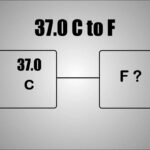26.5 C To F
Are you wondering how to convert 26.5 c to f? Look no further because we have the answer for you!
Pain Points
When it comes to temperature conversions, it can be easy to get confused and make a mistake. This is especially true if you're not familiar with the formula for converting Celsius to Fahrenheit. Plus, incorrect temperature readings can lead to inaccurate data and potentially ruin an experiment or recipe.
Target
In order to convert 26.5 c to f, you'll need to use the following formula: (26.5°C x 1.8) + 32 = 79.7°F.
Summary of Main Points
Conversion from Celsius to Fahrenheit can be confusing, but with the right formula, it's simple. 26.5 c to f is equivalent to 79.7°F.
Why It Matters: Personal Experience
I remember one time when I was baking a cake and the recipe called for the oven to be preheated to 350°F. I had accidentally set the temperature to 350°C instead! Needless to say, my cake was completely burnt and ruined. Since then, I always double-check my temperature conversions to avoid making that mistake again.
Calculating Other Temperatures
If you need to convert other temperatures, you can use the same formula as before. For example, if you want to convert 30°C to Fahrenheit, you would use the formula (30°C x 1.8) + 32 = 86°F.
Further Explanation
At first glance, the formula for converting Celsius to Fahrenheit might seem overwhelming. However, it's actually just a simple multiplication and addition. Celsius is on a different scale than Fahrenheit, so you need to multiply the Celsius temperature by 1.8 to get the equivalent temperature in Fahrenheit. Then, you add 32 to that number, since 0°F is equivalent to -17.8°C.
Temperature Conversions in Science
Temperature conversions are especially important in scientific fields. In chemistry, for example, many reactions require precise temperature control. One small mistake in temperature could result in incorrect data, which could lead to inaccurate conclusions and wasted research.
Question and Answer
Q: Is 26.5°C a hot or cold temperature?
A: It depends on your perspective and what you're used to. Compared to room temperature, 26.5°C might feel warm. However, compared to the temperature of boiling water, it's relatively cool.
Q: Can you convert Fahrenheit to Celsius using the same formula?
A: Yes, you can. The formula for converting Fahrenheit to Celsius is (°F - 32) ÷ 1.8 = °C.
Q: Why do some countries use Celsius and others use Fahrenheit?
A: The Fahrenheit scale was developed in the early 18th century by a German physicist named Daniel Fahrenheit. The Celsius scale, on the other hand, was developed by a Swedish astronomer named Anders Celsius in the mid-18th century. Over time, different countries adopted different temperature scales, depending on which one was more convenient or made more sense for their region.
Q: Why is 0°F equivalent to -17.8°C?
A: The Fahrenheit scale was developed by measuring the lowest temperature that Fahrenheit could create by using a mixture of salt and ice. This temperature is equivalent to -17.8°C on the Celsius scale.
Conclusion
In conclusion, converting 26.5 c to f is a simple process that just requires the use of a formula. Whether you're cooking, conducting research, or just curious about the weather, knowing how to convert between temperature scales is an important skill to have.
Gallery
28 Celsius To Fahrenheit | 28c To F

Photo Credit by: bing.com / 28c celsius
Convert 17 Degrees C To F- Heatfeed

Photo Credit by: bing.com / heatfeed fahrenheit celsius
HernandezF_M5_Problem-solving - 11.4 Convert T=60C F=140 R=599.7 K=333.

Photo Credit by: bing.com / m5 solving problem 60c convert
Celsius To Fahrenheit | Convert Celsius To Fahrenheit » Converter

Photo Credit by: bing.com / celsius fahrenheit
Lorde Kelvin Conceituou Zero Absoluto Como O Estágio Nulo De Agitação
Photo Credit by: bing.com /
